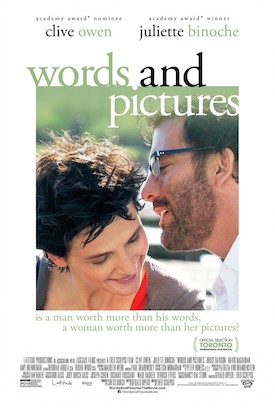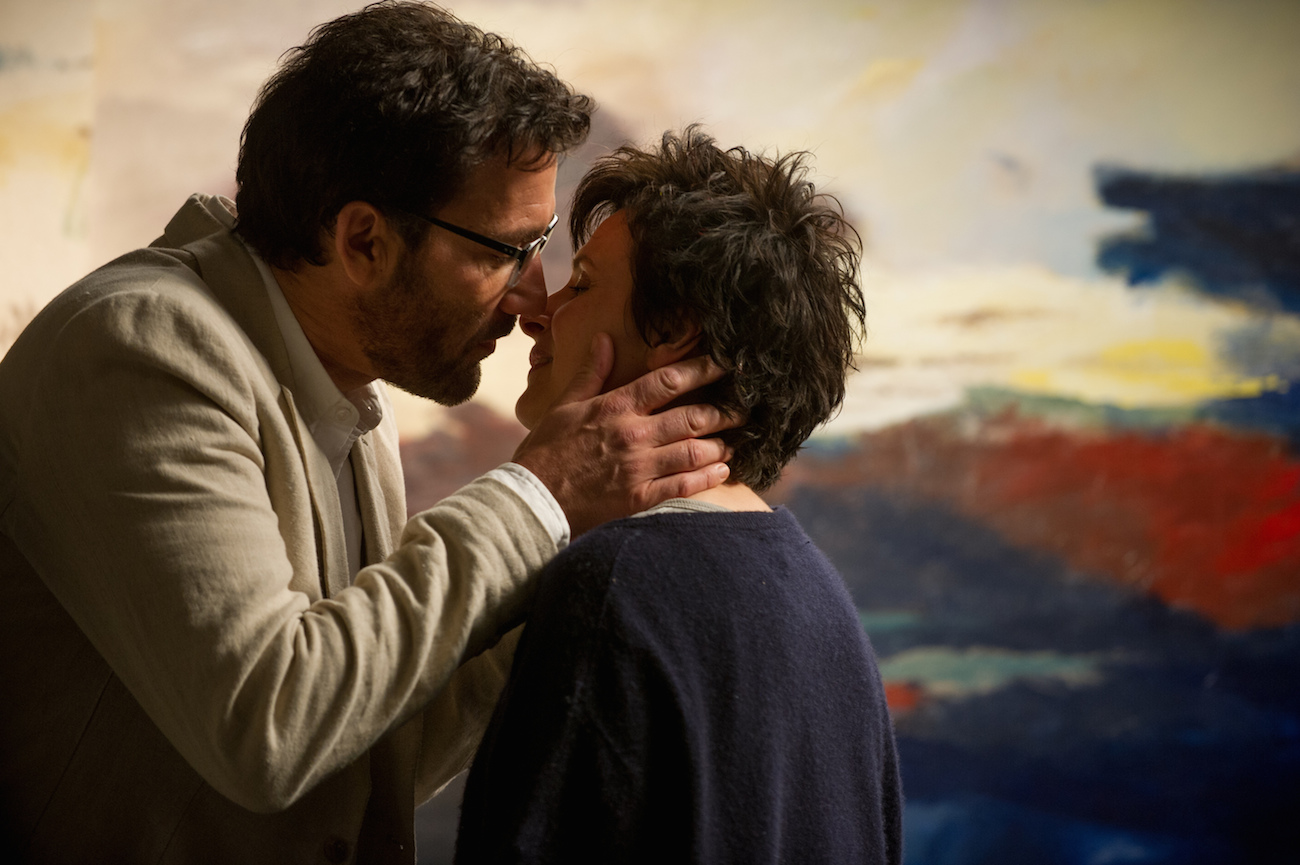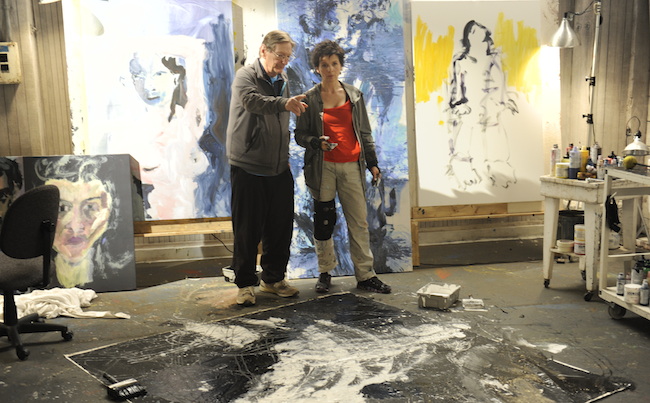 At an exclusive New England prep school, English teacher Jack Marcus (Golden Globe winner Clive Owen) laments his students’ obsession with social media and good grades rather than engaging with the power of the written word. A one-time literary star, Jack has not published in years, spending more time now with the bottle than the art of language. He meets his match in Dina Delsanto (Oscar winner Juliette Binoche), an abstract painter and new teacher on campus, now suffering from a degenerative disease. With a performance review looming and his teaching job on the line, Jack hatches an inspired plan for galvanizing student interest in their studies: he declares a war between words and pictures, confident that the former can convey greater meaning than the latter. Dina and her art students accept the challenge between Jack and his English students, and the battle lines are drawn. With a screenplay by Gerald DiPego, Words and Pictures also stars Bruce Davison, Navid Negahban and Amy Brenneman.
At an exclusive New England prep school, English teacher Jack Marcus (Golden Globe winner Clive Owen) laments his students’ obsession with social media and good grades rather than engaging with the power of the written word. A one-time literary star, Jack has not published in years, spending more time now with the bottle than the art of language. He meets his match in Dina Delsanto (Oscar winner Juliette Binoche), an abstract painter and new teacher on campus, now suffering from a degenerative disease. With a performance review looming and his teaching job on the line, Jack hatches an inspired plan for galvanizing student interest in their studies: he declares a war between words and pictures, confident that the former can convey greater meaning than the latter. Dina and her art students accept the challenge between Jack and his English students, and the battle lines are drawn. With a screenplay by Gerald DiPego, Words and Pictures also stars Bruce Davison, Navid Negahban and Amy Brenneman.
Australian director Fred Schepisi has worked with some of the greatest actors in the movies. His films include The Devil’s Playground (1976), Plenty (1985), Roxanne (1987), A Cry in the Dark (1988), Six Degrees of Separation (1993) and the HBO mini-series Empire Falls (2005). I sat down with him in Los Angeles.
Danny Miller: The chemistry between Clive Owen and Juliette Binoche is so great in this film. With actors of this caliber, is it just a given that they’ll be able to pull that off or do such things worry you during the casting process?
Fred Schepisi: It’s always a concern! Clive and Juliette had always wanted to work together. I first got them together in a hotel in New York. We sat down and had a good chat and…BANG! I knew it was going to work. They had similar thoughts about the material, similar thoughts about work, and a very similar sense of humor.
As great as they are, if this was a big studio movie, I wonder if you would have been able to cast two 50-year-olds in the leads.
(Laughs.) A big studio never would have made this film. Robert Altman used to say, “They make shoes — we make gloves!” Long ago I used to winnow around in the studio system because they did make these kinds of films from time to time. They used to look at their slate of films like a meal. You have your meat and potatoes, you have some vegetables, you have garnish, but now it’s a whole different thing — they just care about their big “tent-pole” movies.
Oh well — at least you don’t have to endure any notes from clueless studio executives!
Thank God. “Why do the characters do this? I can’t follow this story. Can you change that scene?”
“Lose the arthritis — our focus group said it was too depressing!”
(Laughs.) Yeah, yeah. Exactly!
The paintings that Juliette Binoche’s character paints are absolutely stunning. I was shocked during the closing credits to discover that Binoche actually did all the paintings herself. When you were looking for someone to play Dina, were you intent on getting someone who could paint?
I wanted whoever played that role to have some kind of talent — at least enough to fake it! And I definitely wanted someone who had a love of art. I was aware that Juliette had done some painting in a previous film, I think they were charcoal portraits, but I had no idea of the depth of her talent and experience. Man, was I happy when I found that out!
How did you decide what Dina’s paintings would be?
Juliette and I did that together. She was mostly a portrait painter, so in the course of making this film she kind of goes on the same journey as Dina, though for different reasons. We worked a long time to come up with Dina’s style. Juliette was exposing me to artists, I was exposing her to artists, and we were talking a lot about mood, color, attitude and emotions. We set up a studio in the house where Juliette was staying and then, when we built the art studio on the set, she would work there as well. We kept shifting the schedule to give her more time to paint.
Where are all those amazing paintings now?
Juliette has them all in France!
I know that your wife, Mary, is a visual artist as well. Did that influence your understanding of this character?
It helped, yeah. I’ve always been interested in art. My DP, Ian Baker, and I, along with our Production Designer, Patrizia Von Brandenstein, worked with a lot of textures and lighting and compositions from various paintings.
The scenes in which Dina is actually creating art are really gorgeous to watch.
I picked up early on that we wouldn’t be able to stop and start during those scenes, that’s just not how Juliette works. We put two cameras on her when she was painting and I was constantly yelling to the camera people, “Move over there! Get up closer to that! Go to the other side!” We just allowed to her to paint and paint and even make some terrible mistakes! So her experimentation with this character was actually happening on camera and it had an amazing spontaneity.
And the equipment Dina adapts because of her rheumatoid arthritis, was that based on what artists who have that disease really use?
No, not really, we just tried to imagine what this character would do. The chair was Juliette’s idea, and she also had the idea of using those big brushes. I also wanted Juliette’s art to be very accessible, I didn’t want looking at the art in the film to be like taking medicine for people — I wanted it to be beautiful and emotional.
Whenever I watch movies about artists — real or fictional — it always inspires me to stop worrying so much about making mistakes even though there’s often a part of me that wants to scream at the character, “Stop! You’re ruining it!”
It’s only in making the mistakes that you start to refine what you’re doing.
Which, I think, has parallels in writing, too.
Absolutely!
Those kids in the film were excellent. Were most of them from that school where you filmed?
Many of them were — the one’s you see in Dina’s art class were from the art program at that school.
Oh, so the work we see them doing is actually their own?
Yes. It’s so different for kids today compared to my day. Part of the reason I wanted to do this film was to explore the situation in schools in this new technological age. How are kids responding or not responding? It’s all part of the environment that Clive and Juliette have to deal with.
Do you think it’s harder to get films like this made today than it was 20 or 30 years ago?
It sure isn’t easy! Luckily, we had some independent financing that came out of Texas from people who like interesting films. But it took me five years to get it going.
Wow — even with such great actors? It must be tough to find a window after all that time when everyone can do it.
That’s honestly the most difficult part of the whole thing. It’s a nightmare when you finally get the money but then you can’t get the actors who have already agreed to do it. We had a really long gestation period for this film but then we worked really fast. We started pre-production in March and we were in the Toronto Film Festival that September.
Holy crap, that is fast! I also really admired your great supporting cast. Were those mostly people you had worked with before?
I’d worked with Bruce Davison on Six Degrees of Separation but that’s it. Navid the Headmaster was the bad guy from Homefront and Amy Brenneman was suggested by my producer Curtis Burch. I always like to get really good actors even for small parts. They do it because they enjoy working on films like this — it’s not for the paycheck, believe me!


